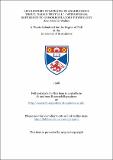Life history strategies in anadromous trout, 'Salmo trutta L.' : with special reference to osmoregulatory physiology
Abstract
1. Juvenile trout, Salmo trutta L., from three parental groups - sympatric Sea trout and freshwater-Resident trout, and isolated trout from above a waterfall impassable by upstream migrating anadromous trout - were reared under three ration regimes to manipulate growth rates. The development of seawater tolerance was studied by measuring drinking rates after periodic salinity challenges during the first two years of juvenile growth. No trout were observed to undergo the parr-smolt transformation in any of the parental form/ration combinations after two years in freshwater. However, a considerable proportion did mature during this time period. The proportion of maturing trout was directly related to ration level but was also influenced by parental form, with isolated trout demonstrating a greater tendency to mature early. Seawater tolerance increased with age in all groups. However, mean drinking rates upon salinity challenge were generally lower, from Experiment 2 onwards, in Resident trout than in either of the other two groups. 2. Eight immature sea trout (finnock) were radiotracked in the River Eden, Fife, during September, October and November 1994. The individual finnock displayed considerable variation in patterns of movement; two remained in freshwater for at least 27 days whereas others moved downstream out of the river within days or even hours of release. In general, this highlighted the transient nature of the freshwater migrations of some finnock, indicating that they move in and out of rivers over brief periods of time and apparently do not necessarily remain in freshwater continuously throughout the winter. 3. The hypo-osmoregulatory ability of finnock during the winter was assessed in two experiments. The number of finnock was limited in Experiment 1. Therefore, this was designed as a preliminary assessment of the physiological response of finnock to acute freshwater-seawater transfer. Osmoregulatory abilities were assessed by measurement of drinking rates, plasma ion and plasma cortisol concentrations after acute freshwater-seawater challenge and compared with freshwater-adapted and seawater-adapted control groups. Finnock displayed physiological responses typical of euryhaline teleosts upon seawater challenge; a rapid increase in drinking rate, an increase in plasma ion concentrations (but only to levels similar to, or slightly greater than, those of seawater-adapted fish), and increased plasma cortisol concentrations. The second experiment, in which numbers of finnock were greater, made use of the same techniques to assess the longer term acclimation of finnock to both freshwater-seawater and seawater- vi freshwater challenge, to establish whether finnock might suffer from a more subtle reduction in seawater-tolerance which would not have been necessarily apparent in the acute challenge of Experiment 1. Finnock did not appear to be physiologically compromised by seawater challenge during the winter months, and therefore, a breakdown in hypo-osmoregulatory abilities alone cannot be considered a reason for finnock returning to estuaries and rivers during the winter. 4. The physiological effects of low to medium levels of infestation of the ectoparasitic copepod Lepeophtheirus salmonis (Kroyer) on wild sea trout post-smolts were assessed at intervals during the development of the parasite. A mean infestation level of 18 parasites caused significant disruption to the osmoregulatory ability of hosts, as demonstrated by significantly higher plasma osmolality and chloride ion concentrations when compared with naive post-smolts. In addition, since no skin lesions were apparent on the hosts, these physiological effects were considered to be the consequence of larval attachment to the gill filaments, thereby possibly puncturing the epithelia and also damaging vital branchial ion excretory cells. 5. The modern molecular genetic RAPD-PCR technique was used to screen DNA of Lepeophtheirus salmonis collected from wild and fanned salmonid hosts from around the Scottish coasts. This technique indicated markedly different patterns of genetic variation amongst L. salmonis of farmed and wild origin, and between different farms. A number of genetic markers were found to be exclusive to, or at considerably higher frequency amongst, sea lice collected from farmed salmonid hosts. This technique established the possibility of assigning provenance to L. salmonis collected from wild hosts.
Type
Thesis, PhD Doctor of Philosophy
Collections
Items in the St Andrews Research Repository are protected by copyright, with all rights reserved, unless otherwise indicated.

